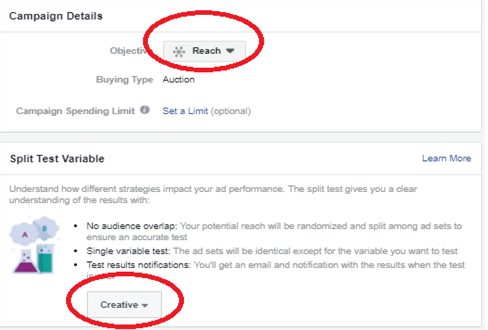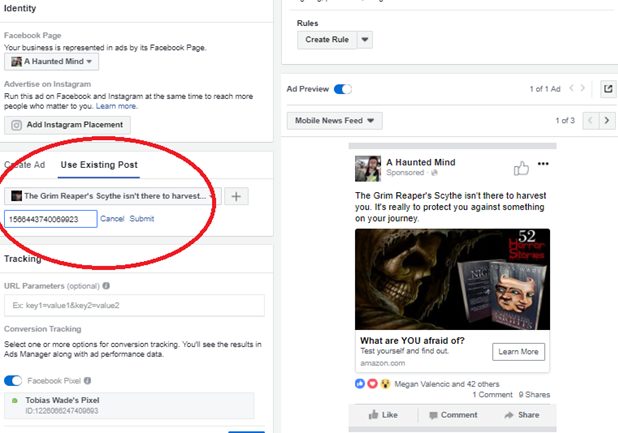Optimizing Facebook Ads
The success of an advertising campaign is determined by its ROI (Return On Investment). This can be measured in more ways than direct sales, but it’s hard for me as an independent author to justify the expense without seeing clear results. This guide is all about creating the most efficient possible advertisement that can work within your budget, and accurately measuring its benefit so you aren’t just flushing money away.
(Note: This guide assumes the reader is already familiar with many advertising concepts. If a specific step is confusing, check YouTube for a guide to go more in-depth on the subject).
Phase 1: Before you create your first ad.
- Create a Facebook Business Page: To maximize the efficiency of your advertising dollar. It helps for people to see your brand, giving them another opportunity to get to know work.
- Create an Amazon Associates ID: While Amazon does not allow you to advertise using a direct affiliate link, you’re still running on a tight margin and need every cent you can get. You are allowed to advertise a landing page which then uses an associates link. This has the added benefit of giving you a way to track the sales from your campaign.
- Setup a Facebook Ad Account.
Phase 2: Create a custom audience.

- In the Facebook Ads manager, search for “Audience Insights”. It will give you a (scary) amount of information on various potential audiences. Make a note of any striking trends for your targeted demographic.
- Search for “Audiences”, “Create Audience”, then “Create a Lookalike Audience.” Create one for your mailing list, Facebook fans, and website visitors (if you have a Facebook Tracking Pixel installed on your website).
Phase 3: A/B Split Testing.

- When you create a new campaign, you’ll be given the option to split test. This step can be performed multiple times, changing one element each time and evaluating the results.
- I will be using my saved lookalike audience and won’t be varying the demographics in this tutorial. I also won’t be varying placement (Using “Feeds” only is almost always more effective). What I will split test is:
- Headlines: 4-5 words. Value Driven. Short. Punchy. Clear.
- Pictures: Immediately demonstrates genre.
- Description: Most effective ads average only 14 words. Try to engage your audience by asking a question or encourage them to interact with your ad.
- This campaign will be targeted at the lookalike audiences you created earlier. Now is also the time to refine that audience more closely with any of the trends you found in “Audience Insights”.
The trick here is to only target the lowest CPC (Cost per click) countries while optimizing your ad and building social proof. Of that list, I’ve personally gotten the best results from the Philippines, India, Pakistan, and South Africa. (Remember to set English speaking as one of the ad requirements). The reason you set this ad as a “Reach” objective is because you want to accumulate a lot of likes/comments/shares to improve the conversions when you start driving traffic.
Phase 4: Traffic Campaign.

- Copy the “Post ID” from your most effective split tested reach campaign (the last numbers at the end of the url for that post), and use that to create a new campaign with the “Traffic” objective. Make sure the previewing ad on the right still has all the social proof from your reach campaign.
- Target this ad at your actual mailing list, Facebook followers, and Website visitors (you can use the lookalike for this too if your audience size is too small, but ideally you want to target a warm audience who already knows about you somehow).
Phase 5: Evaluating Results

Check your Amazon Associates and look for the click-spikes that match up with your ad. Now time for some math:
Let’s say you have a 3.99 eBook, and you’re making 2.50$ per book sale.
Plus 4% from Amazon Associates = $2.65 per sale.
If 20% people who click your link buy your book, then you’ll make a profit as long as you can get your CPC to .53 cents or less.
Even if you aren’t breaking even, try to keep track of other factors such as people liking your Fanpage or joining your mailing list. Some things will be more difficult to quantify, like extra sales you’re getting from your increased rank or future purchases your new fan makes.
Because of those other factors, I’ll consider any ad that even gets close to breaking even a success. Facebook ads are an art as much as they are a science, so good luck experimenting and may the best book win!

23 thoughts on “How to to Make Money From Facebook Ads: A Guide for Authors”
Comments are closed.